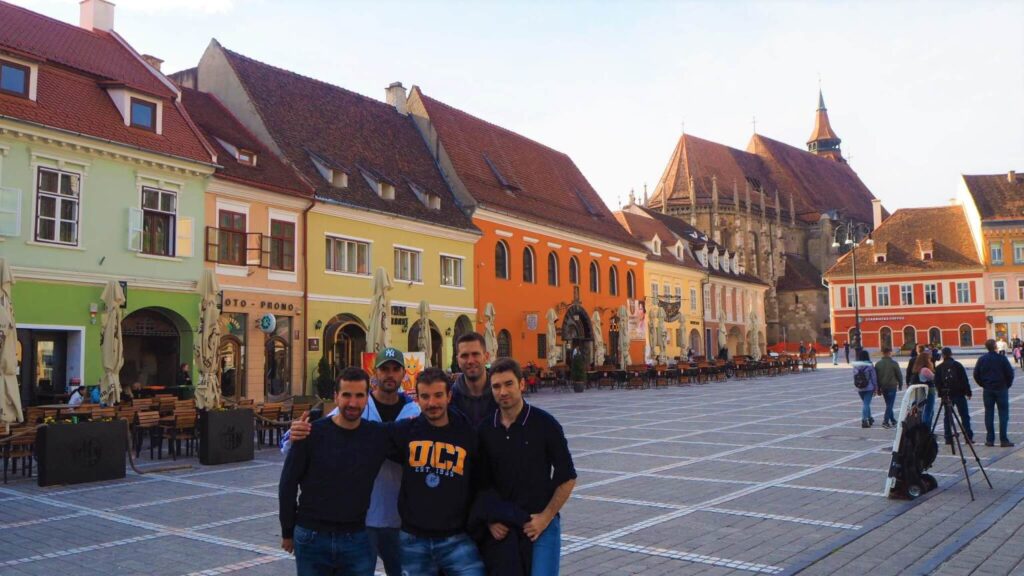As you might remember from the previous post, after watching the sunrise, we walked to our hostel. It was a nice way to put an end to the weekend in Bucharest. After saying goodbye to Fabrizio (unfortunately he needed to fly back to Germany to attend University), we got ready to keep discovering Romania. To that extend, we had rented a van with “Alana Rent A Car” through Eurocars.ro. We wanted to drive through Transylvania and check different places. The itinerary for our first day included Peleș Castle and Brașov.
I’m not a big fan of car rental companies. Most of the times the try to scam you. But, to be fair, this time, we didn’t have a single problem or hidden fine print. The guy from Alana showed up at our hostel at 11:00, as we had agreed. We were going to have the van from Sunday morning till Tuesday evening. So, two days and a half. The van could accomodate nine people and it was pretty new. We paid 360 Euros and that included full insurance, meaning, we didn’t have to leave a deposit. In a nutshell, we got a good vehicle, at a fair price and with no hidden surprises. So, if you are considering renting a vehicle for your trip in Romania, give them a try!
A flat landscape without gas stations

They gave us the van with the tank almost empty. We told them we would return it with the same amount of fuel and that wasn’t a problem. It took us a while before we finally left Bucharest. The traffic was way better than the day we arrived but, yet, coming out of such a big city took us some time. We agreed upon filling the tank as soon as we saw a gas station on the way to Peleș Castle. The problem? We didn’t see a single gas station by the road.
We saw plenty of rest areas. The landscape was kind of dull. There wasn’t much to see. It was pretty flat and other than some fields and some antennas we didn’t see anything remarkable. We drove for almost an hour and no sign of gas stations. The pessimism started to take over the group but I was confident we would find something. If not, it would just make the journey more adventurous lol.
And, as you can see in the picture below, we did find a gas station. But it wasn’t by the motorway. So, just to let you know, there are gas stations in towns and cities, but not by the road, like we have in Spain. And that was a constant throughout our trip in Transylvania. Thus, if you want to avoid adventurous journeys, make sure you leave the city with your tank kind of full 🙂
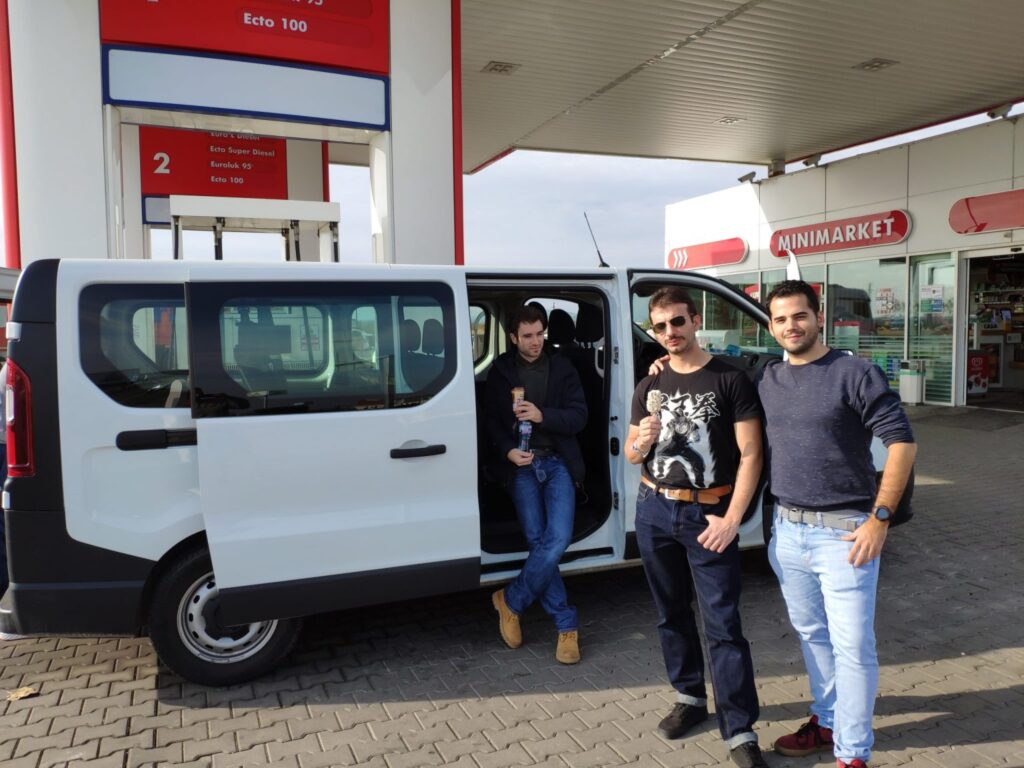
Peleș Castle
It took us around 2 hours and a half to make it to Peleș Castle. The road (a motorway) was pretty good. Nothing to do with what we had read. What was going on? Easy: we were driving on one of the few motorways we would see during our trip through Transylvania. The rest would be national roads and… that would be another story. But, don’t worry, there will be more on that topic in future posts. Being the road a motorway, we didn’t get to taste the crazy Romanian driving skills.
As we were entering the Peleș Castle area, one of the men working there approached us and showed us were to park our van. There were parking lots closer to the castle but they were already full. We paid around 30 LEI for our spot and we started walking. The walk to the entrance took us around 20 minutes but, after the first 10 minutes, we started to appreciate the magnificence of the building we were about to enter. It looked like this:

We kept walking and awing. And taking some pictures, of course! I had seen a few castles in my short life but, nothing like the one I had in front of me. It was breathtaking. The more we walked the more we awed. The closer we got, the more spectacular it looked.

About Peleș Castle
Peleș Castle is a Neo-Renaissance castle in the Carpathian Mountains, on an existing medieval route linking Transylvania and Wallachia. The castle was inaugurated in 1883, although, due to further major improvements, the construction went on from 1873 to 1914. Peleș Castle was built by King Carol I of Romania, under whose reign the country became independent from the Ottoman Empire.
When the King first visited the area of the castle in 1866, he fell in love with the astonishing mountain scenery. It was then that he decided he would build his castle there. King Carol I rejected all three first design plans submitted for Peleș Castle, as he considered them mere copies of other palaces in Western Europe, lacking originality. German architect Johannes Schultz won the project by presenting a more original plan: a grand palatial alpine castle combining different features of classic European styles.
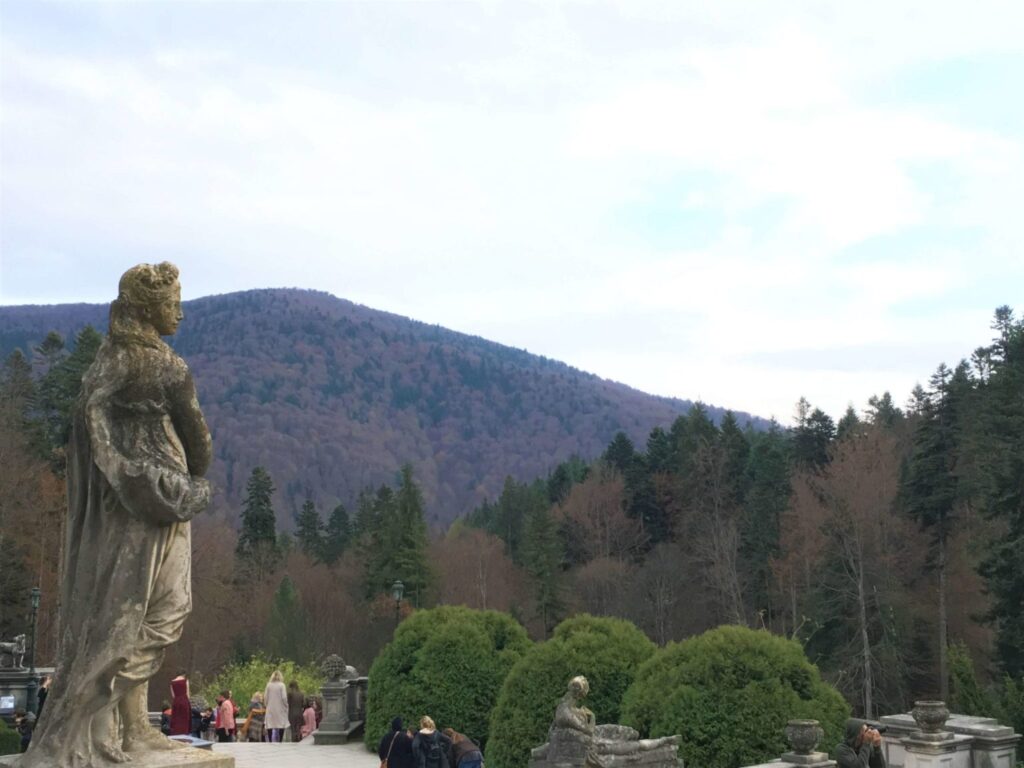
Peleș Castle became the first world’s castle fully powered by locally produced electricity. It was a milestone back then. Throughout history, the castle hosted some important personalities, from royalty and politicians to artists. All of them awed to such masterpiece. Although, like always, there were some exceptions to the rule: Ceauşescu did not like the castle much and he rarely visited it.
By form and function, Peleş is a palace, but it is consistently called a castle. Its architectural style is a romantically inspired blend Neo-Renaissance and Gothic Revival. Interior decoration is mostly Baroque influenced, with heavy carved woods and exquisite fabrics. It has more than 170 rooms categorised by function or style. The establishment has collections of statues, paintings, furniture, armours, gold, silver, stained glass, ivory, porcelain, tapestries and rugs. So, as you can imagine, it is a truly masterpiece.
Visiting Peleş Castle Museum
As of today, the castle is a symbol of tourism, with public visits (with guided tours) to the different rooms within the museum. Admission is charged and there is also an additional photography fee. We didn’t know about the photography fee until a lady, whose only job was that, told us that, if we wanted to take pictures, we had to pay the photography fee… I had run into similar bull*hit before, but, still, I can’t understand such a robbery.
The fee for visiting the ground and the first floor is 30 LEI and, if you also want to visit the second floor, the total price is 60 LEI. The museum is open from Wednesday to Sunday from 09:15 to 16:15 (except on Wednesday when the opening time is at 11:00). On Tuesday, you can just visit the ground floor and the museum is closed on Monday.
We arrived at the entrance of Peleş Castle at around 15:00. We checked the surroundings and made it to a some sort of courtyard. The architecture and detail were really beautiful.

From the courtyard, we turned right at the lamp and we made it to the entrance of the museum. We didn’t understand very well the prices and the visiting options and we ended up paying 30 LEI, thinking we were going to visit the whole museum without a tour guide lol. We waited for a bit until other groups left the building and then we entered.
It turned out that we had an English tour guide and that we were going to visit the ground and first floor (as I had explained above), but not the second one. We found out at the end of the tour lol. From the moment we stepped in we were delighted by so much beauty. Just to give you an idea, the ceiling of the hall looked like this:
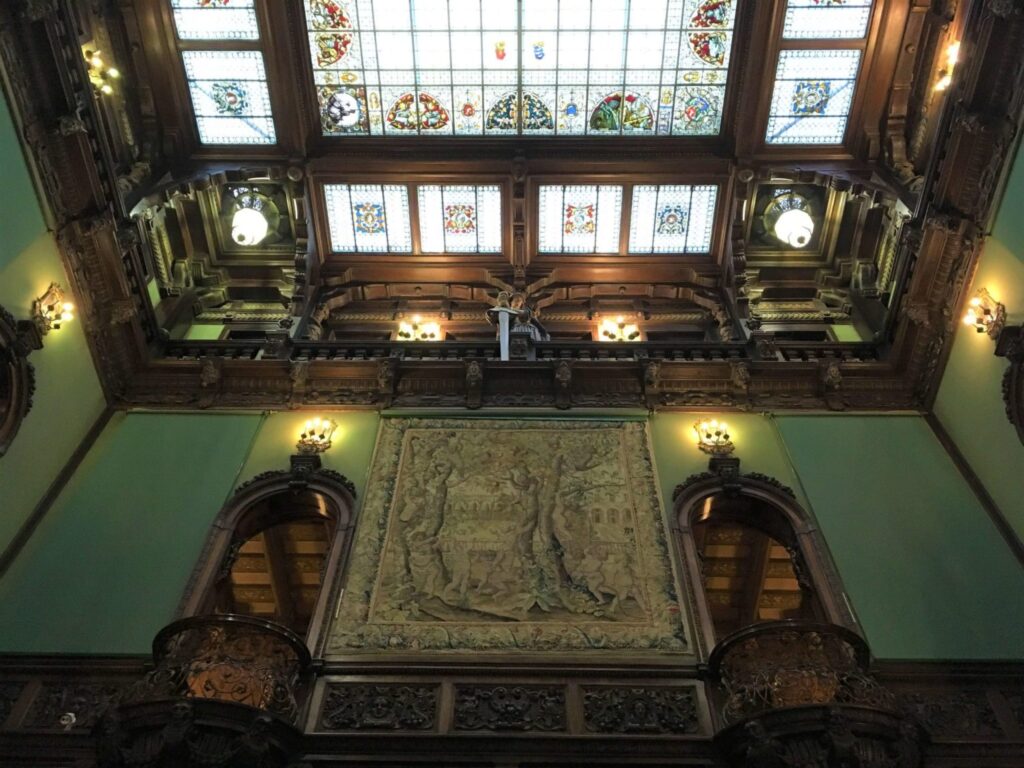
We went upstairs and our tour guide started explaining some aspects about Peleş Castle. We learnt about its dates of construction, about King Carol I, about the architecture style and about its electricity system, an impressive achievement for its time.
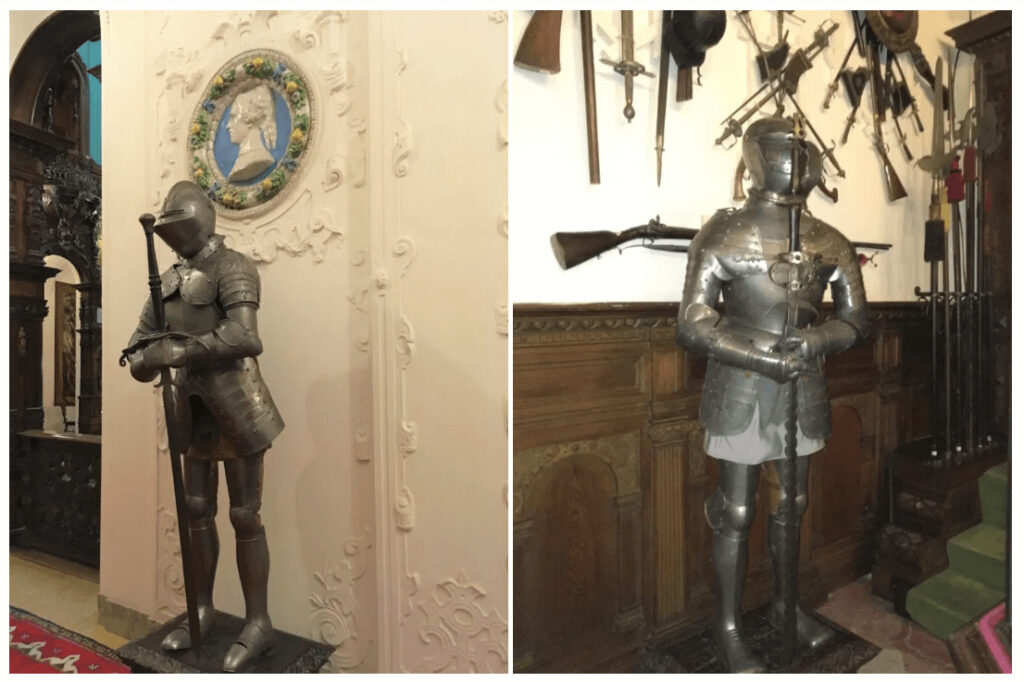
The information our tour guide was giving us was interesting, but, with every step we took, it started to pale in comparison to what our eyes were seeing. We saw impressive stained glasses, paintings, armours, statues, furniture and much more. At the Grand Armory room we saw hundreds of pieces of weaponry and even the Maximilian horseman armor!
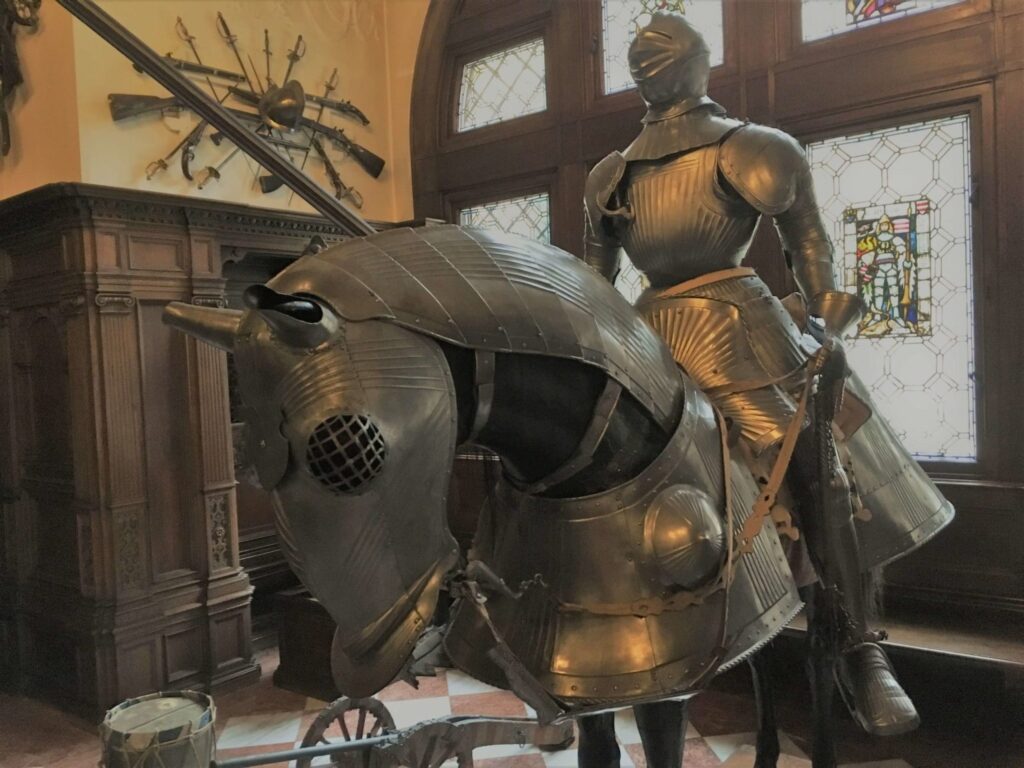
The museum has elements from different styles, ages and cultures: the Italian Renaissance, the Persian, the Ottoman Turks, the Hispanic Moorish, the Austrian, etc. Carved woodwork walls and majestic rugs were a constant throughout the tour. But also the lamps. Some of them were incredible masterpieces. Just as this one:
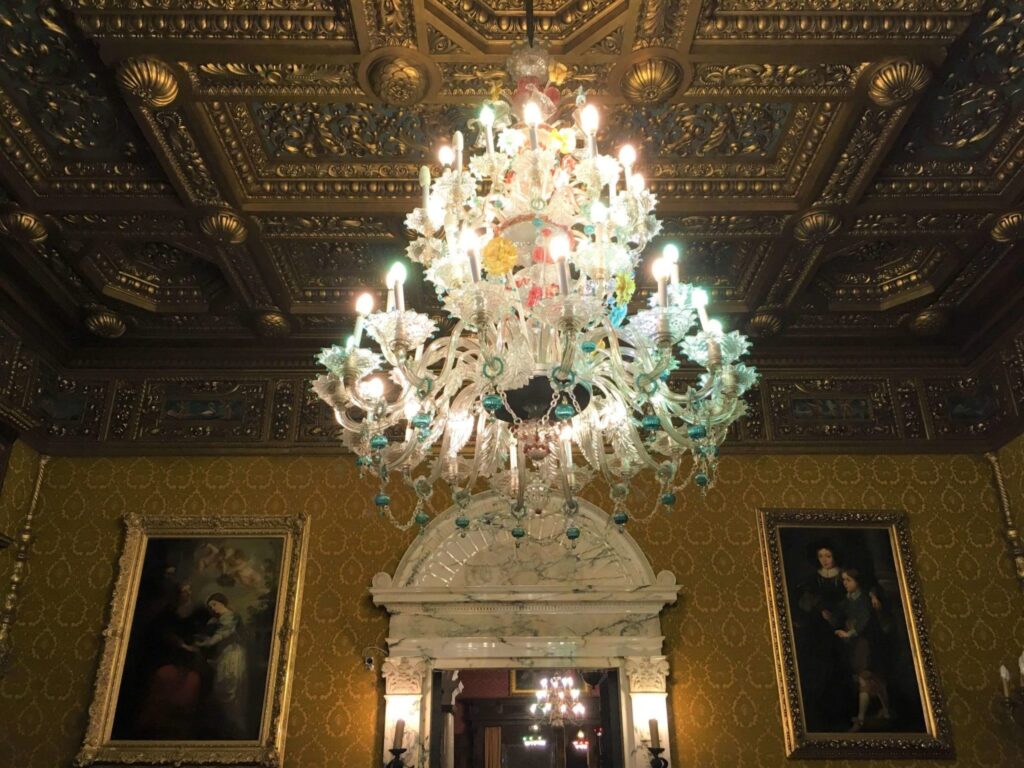
After an hour or so the tour came to an end. It was then that we found out we couldn’t visit the second floor because we had just paid for the “regular” ticket. These were our faces after finding out:

Both Peleş Castle and its museum were truly amazing. The views of the building were astonishing, but the beauty of every single piece of art we saw inside the museum didn’t fall behind. All in all, if you are going to spend more than a few days in Romania, you really need to come check this masterpiece, it is absolutely worth it 😉
On the way to Braşov

I was the one who drove the van from Bucharest to Peleș Castle and now it was time for my cousin Paco to drive it from Peleș Castle to Brașov. I was kind of tired from the last night in Bucharest and I thanked him for that. That was one of the good things about having 6 of us in the van: we could share the driving times. I felt I was going to fall asleep as soon as he started up the engine but it wasn’t quite like that. It turned out the road from Peleș Castle to Brașov wasn’t a motorway anymore…
It was on this route that we started to get a taste on the “famous” roads of Romania as well as on the driving skills of its people. The road was full of curves and, when I say full, I really mean it. Back home, in Valdepeñas, we have similar roads so we were kind of used to it but, still, at some points, it seemed a little bit too much. The good thing about them though was that we never found them narrow. There was always enough space for two cars.
The landscape was different and more beautiful than the one from Bucharest to Peleș Castle. It wasn’t dull and flat anymore, but full of mountains and pine trees whose colours went from green to yellow to reddish-brown. The mountains we were watching weren’t just any mountains, but the Carpathians. The biggest “problem” we faced was the lack of habit driving “against” the Romanian people, meaning, they would try to overtake you with little visibility or none 😅.
About Brașov
Founded by the Teutonic Knights in 1211 on an ancient Dacian site and settled by the Saxons as one of the seven walled citadels, the city of Brașov played an important role as the intersection of trade routes linking the Ottoman Empire and Western Europe. This was reflected in the city’s German name, Kronstadt, as well as in its Latin name, Corona, meaning Crown City.
Fortifications around the city were erected and continually expanded, with several towers maintained by different craftsmen’s guilds, according to the medieval custom. Part of the fortification ensemble was recently restored using UNESCO funds. The city centre is marked by the mayor’s former office building (Casa Sfatului) and the surrounding square (Piața Sfatului), which shares the name of the building. Nearby is the “Black Church” (Biserica Neagră), which is the largest Gothic style church between Vienna and Istanbul.
As of today, the city has become one of the main touristic choices in central Romania. It is surrounded by the Southern Carpathians and it is part of the historical region of Transylvania. With its central location, Brașov is a suitable location from which to explore Romania, and the distances to several tourist destinations (including the Black Sea resorts, the monasteries in northern Moldavia, and the wooden churches of Maramureș) are similar. It is also the largest city in a mountain resort area and its metropolitan area is home to 300000 residents.
Brașov
We arrived in Brașov at around 17:00. The sun was about to set. We had done some research on where to park for free in Brașov and thus, we drove to “Strada Castelului” and “Strada Cerbului”. We checked both of them and they were pretty full but, after driving around for a bit, we found a parking spot big enough for our faithful van.
Where to stay in Brașov?
We had booked a room for 6 at “JugendStube Hostel”. The hostel was 5 minutes by foot from “Strada Republicii”, one of the key streets in Brașov. The street was full of bars, restaurants, shops and people walking around. We arrived at the hostel and, after speaking with the kind lady at the reception, we made it to our room. The hostel was way better than the one in Bucharest. It was way cleaner, it had reception 24 hours, the room was bigger and the beds were more comfortable. And, we paid around 10 Euros per person, with (a proper) breakfast included. Not bad, huh? If you come to Brașov, don’t hesitate and check it out!
The lady was from The Philippines and you could feel it. She was super kind and attentive. She provided us with info about the city and answered to any questions we could have. We thanked her for her time, left the hostel and started walking to a restaurant where we could have dinner. It was 19:00 but last time we had eaten something was… long time ago… it goes with the trip 😉
Dinner at Cucinino Pasta Bar
We decided to go to an Italian restaurant for a change and that’s how we ended up at “Cucinino Pasta Bar”. The restaurant wasn’t huge but it was cozy. There were some people already having dinner so I guess we weren’t out of place lol. We got a table and started ordering. We were super hungry! And I guess that was the reason why half of the group ordered 500 g of “rigatoni alla boscaiola al forno” 🙂

We enjoyed the dinner, the drinks and the company. The place’s decoration was pretty cool and the service was good. Prices were middle-high but, like always, going in a big group and sharing made it cheaper.
Sunday night in Brașov
After such a big dish (and the late partying nights in Bucharest) we felt kind of sleepy. Nonetheless, it was just 20:00 and we refused going to sleep at such a time. We had a reputation to maintain! Thereby, we decided to go with the following route to take a look at some of the places I had written down in our planning.
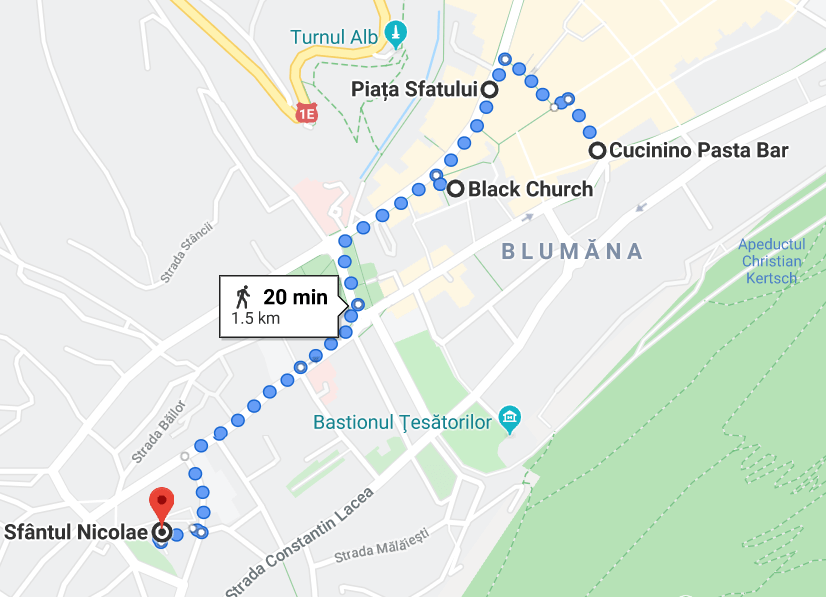
As you can see in the picture above, we were pretty close to “Piata Sfatului”, one of the main squares in Brașov. The square was famous for having colourful buildings all around it but, at that time of the day, we couldn’t really appreciate them. Therefore, we kept walking until our next stop: “The Black Church”. Once again, the lighting wasn’t the best, but, at least, we were able to take the following picture of the clock tower:
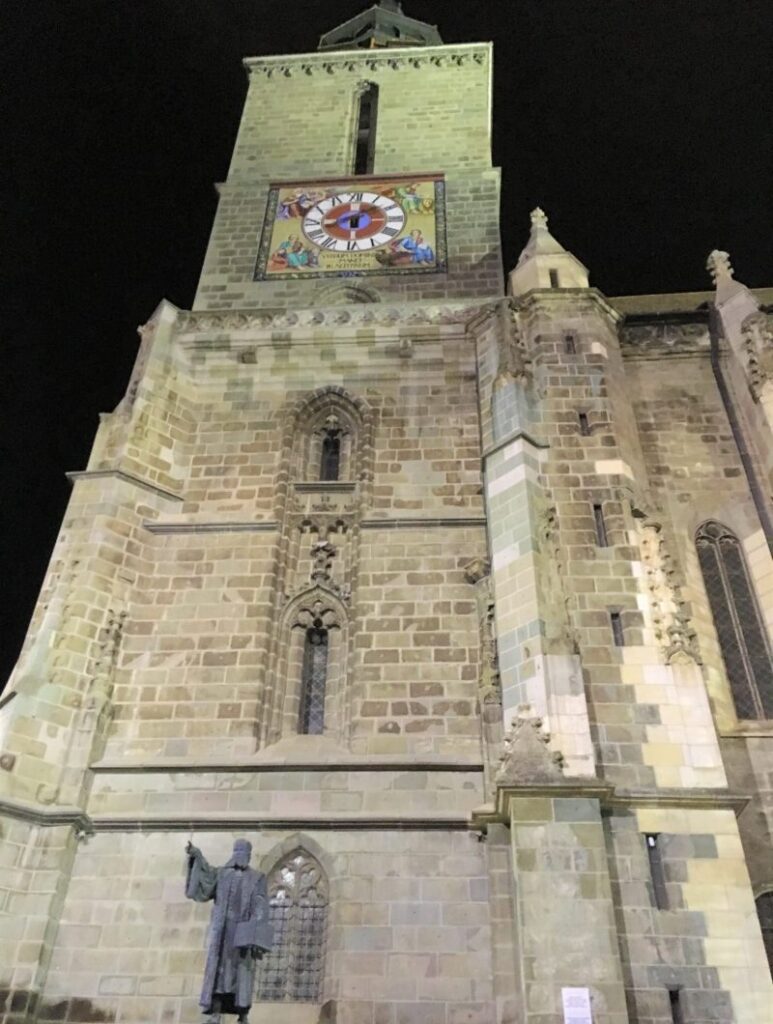
The Black Church is pretty huge and, even if we couldn’t really appreciate its beauty at night, we still enjoyed walking around it. We “thought” we would be visiting it the next morning so it wasn’t a drama. After the church, we walked to “the other great Medieval square in Brașov”, aka “Piata Unirii”. As you can see, some names started to become a constant throughout our trip. We had already seen the beautiful Piata Unirii in Bucharest and we were about to take a look at yet another Piata Unirii (Union Square). And, it wouldn’t be the last one we would see.
Again, it seemed like sightseeing at night wasn’t the best idea, what a surprise! Yet, we made it to Piata Unirii and, after wandering around for a bit, the bright light of a tower guided us to our next destination: “St Nicolas Church”. That church had the best lightning of all the buildings we had seen, so, we could take a proper look at it.

We found a graveyard next to St Nicolas Church. We approached it but didn’t see anyone around, yet, all of a sudden, we started to hear some noises… I guess it was all due to the fact that Halloween had just taken place a few days ago, but, the noises seemed to be there, coming from the graveyard. We took a closer look and saw a light coming from a window of a house. There was a man wandering around… Was he the one who put all those people in the graveyard under the soil? Just kidding lol 🙂
After such a terrifying show, we decided to return to the world of the living by walking all the way back to the starting point. Even if it was Sunday (or maybe because of that) we didn’t see many people at Strada Republicii. I guess our expectations were too high after the weekend in Bucharest lol. We went to check some of the “party” places I had written down on my list but either they were closed or they were completely empty. Thereby, we ended up having a beer at a regular terrace and, from there, we went to JugendStube Hostel to catch a well deserved sleep.
Monday morning in Brașov
We woke up at around 08:30, had some breakfast, picked our luggage and, after thanking the kind Philippine woman at the reception, left the hostel. We then walked to the van, left all the stuff and got ready for some sightseeing (or that’s what we thought).
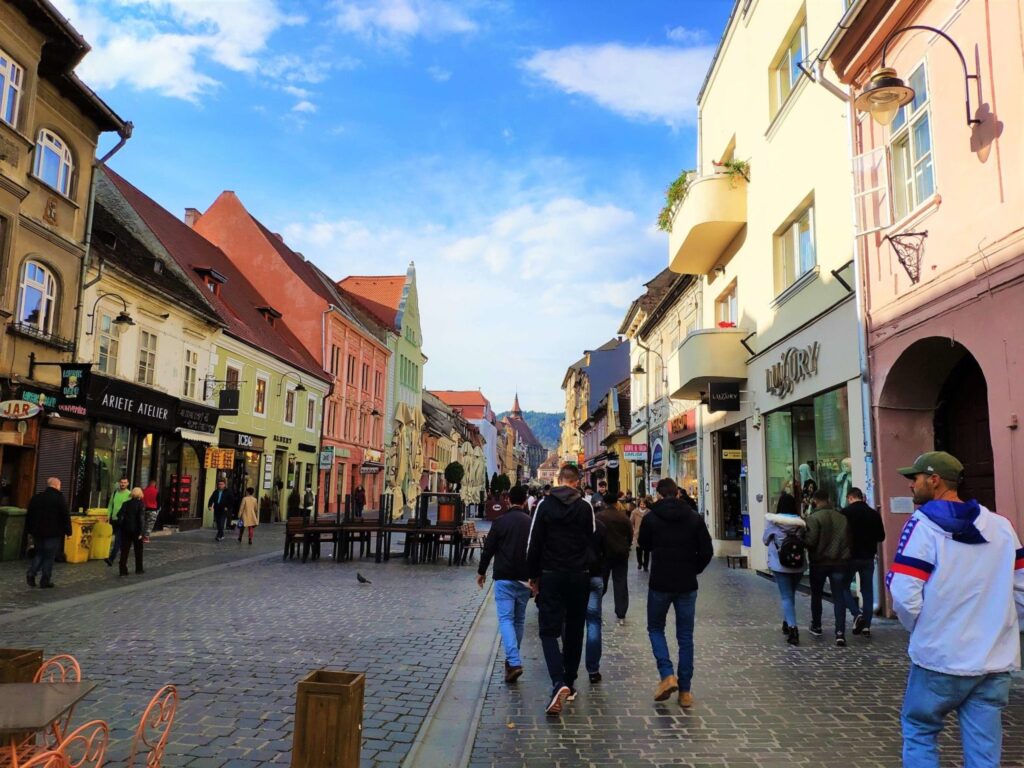
Brașov’s Black Church
The first stop of our Monday morning sightseeing in Brașov was the famous “Black Church”. This huge church was built by the German community of the city. And, as of today, still stands as the main Gothic style monument in the country as well as the largest and most important Lutheran place of worship in the region.
The church was built between 1385 and 1477 on the site of an earlier church (destroyed by Mongol invasions in 1242) and it was known in German as the “Marienkirche”. It was given its new name after being partially destroyed in 1689, due to the Great Fire set by invading Habsburg forces during the Great Turkish War. The fire leveled most of the town, blackening the walls of the church. Restoration took almost 100 years.
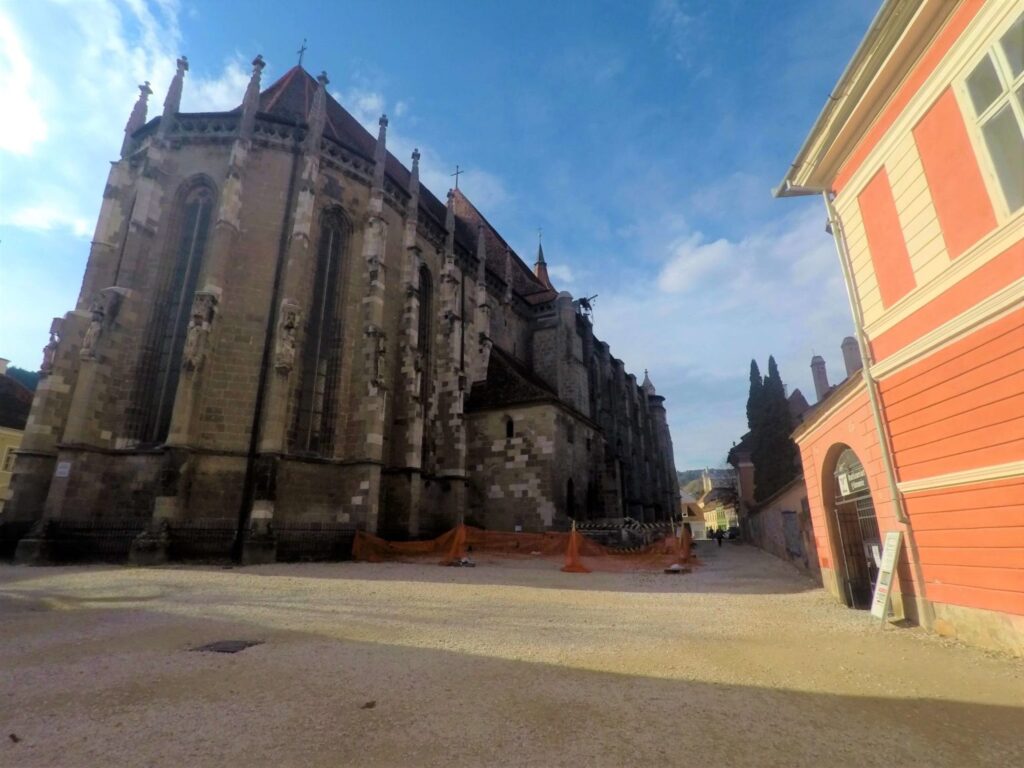
The Black Church has a six-ton bell, the biggest in Romania. It also houses an impressive 4000-pipe organ, built in 1839, as well as a rich collection of Transylvanian rugs donated from the 15th to the 17th centuries by Transylvanian Saxons merchants.
Doesn’t it seem like a pretty interesting and beautiful building? It would be an insult not to visit it while being there, wouldn’t it? Well, guess what, we couldn’t go inside. And why was that? Because, according to my research (and to many websites), the Black Church was open daily. But, reality was slightly different. It turned out that it was closed on Mondays! Thus, following Johannes Honter’s advice, we got the hell out of there 🙂
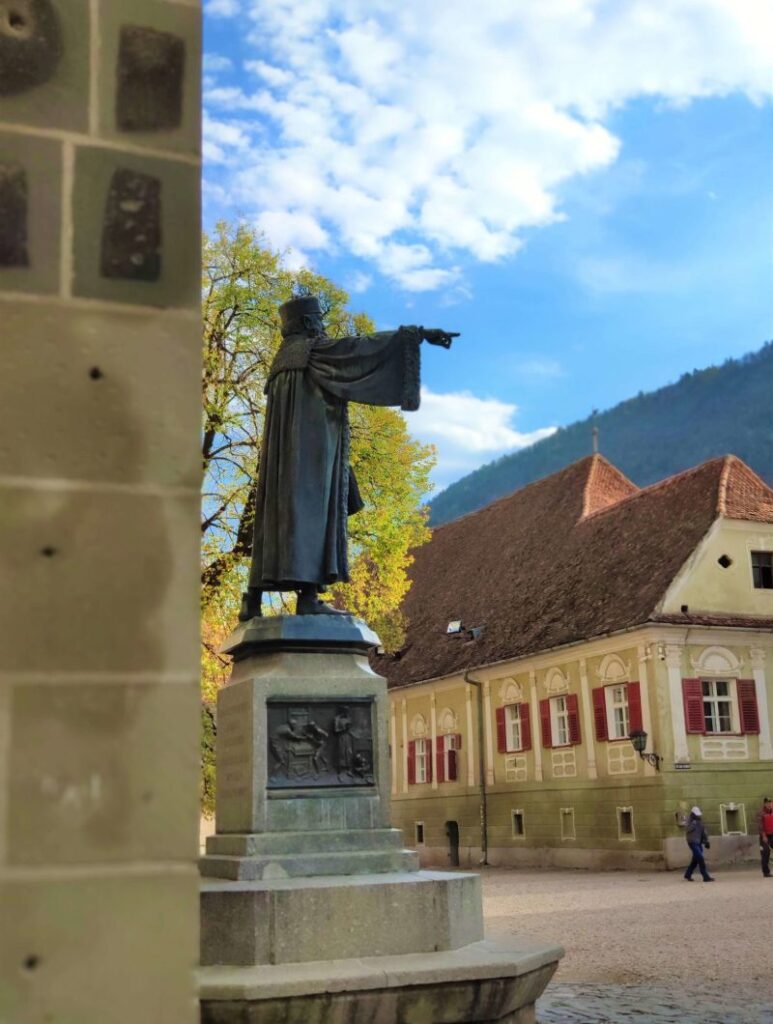
Tâmpa Mount
From the Black Church we walked to “Strada Sforii”, famous for being one of the “narrowest” streets in Europe. We walked down it but, to be honest, we didn’t find it very impressive. It had some nice graffiti but nothing to write home about. So, our next stop was going to be Tâmpa Mount, which is a mountain located in the southern part of the Eastern Carpathians and most entirely surrounded by the city of Brașov.
Why did we want to go there? Well, with an elevation of 960 meters, we thought it could make a nice viewpoint of the whole city. There was the Hollywood-style sign of Brașov and there was also the incentive of Brown bears, who could be seen now and then strolling around. Oh yeah, almost forgot, from the skirt of Tâmpa Mount you can also see some rests of the fortress walls.
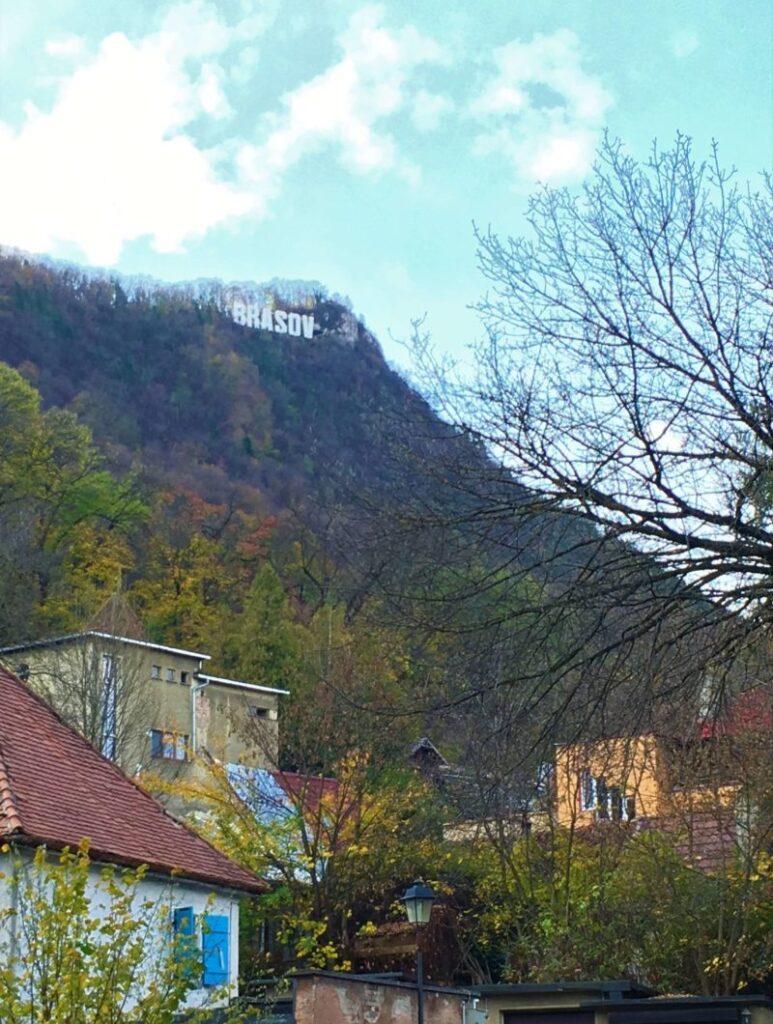
Again, Tâmpa Mount sounds like a fun thing to do, right? Who wouldn’t love to take the cable car, reaching the summit in 10 minutes? Wouldn’t it be perfect to enjoy the views of Brașov on a sunny Monday morning? Could you guess what happened next? Bingo! The cable car was closed! Once more, according to some websites, it was open daily from 09:30 to 17:00. But it wasn’t the case. There was also the possibility of hiking to the top, but it would take around one hour (one way) and we didn’t have the time. So, what have you learnt from this? If you want to do some sightseeing in Brașov, don’t do it on Monday!
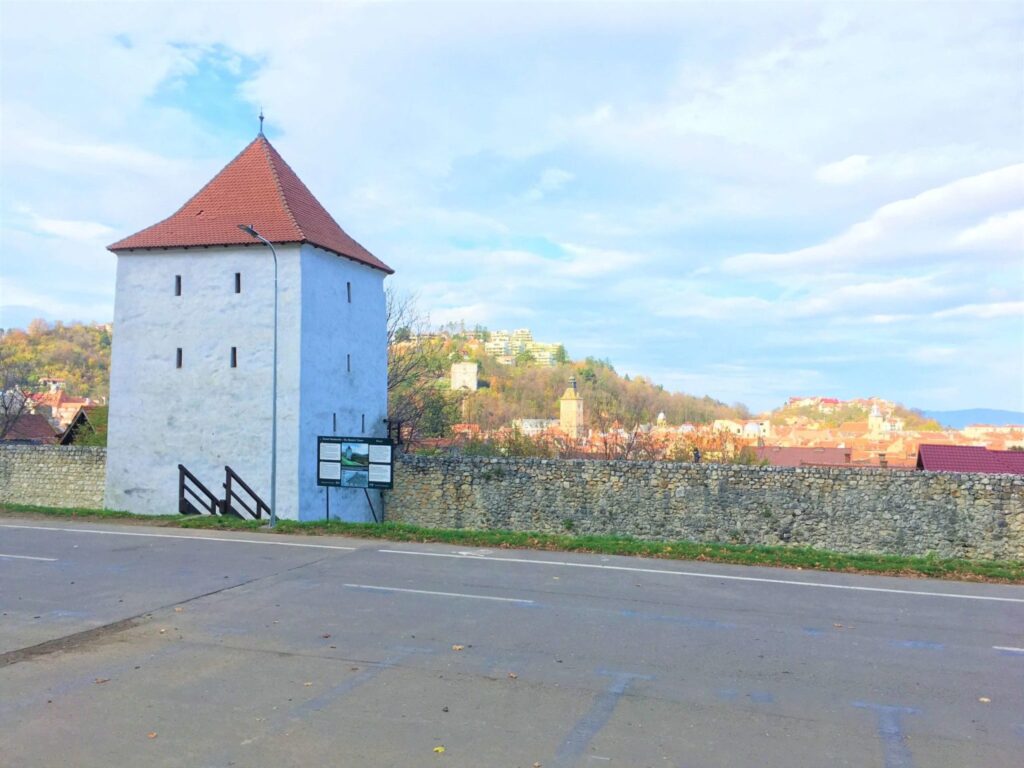
Piata Sfatului
When we realised we couldn’t win against Brașov on a Monday, we accepted our defeat and walked to Piata Sfatului. They couldn’t close a square even if it was Monday, could they?! As we were walking with our fearful thoughts, we started to discern the figure of the “Council House” (Casa Sfatului). It seemed it didn’t have any fences around. We couldn’t believe it but, Piata Sfatului was open!
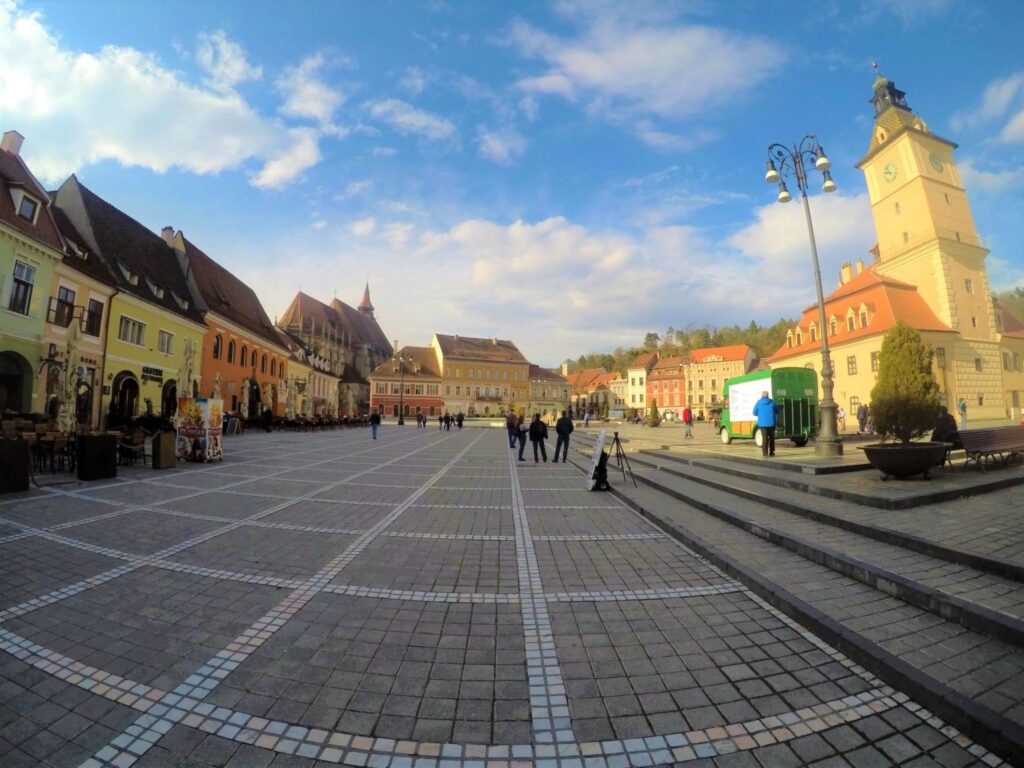
Piata Sfatului is located in the historic centre of Brașov. It obtained its right to hold markets in 1520, but it has been the place for weekly and annual markets since 1364, being visited by merchants from the country and abroad. It is surrounded by beautiful 18th-19th century red-roofed houses, most of which are historical monuments.

The most important building in the square is the former Council House (the yellow one with the tower), which was built in 1420 and is located in the middle of the square. The house served as a meeting place for the town councilors, known as centurions. On top of the building sits the Trumpeter’s Tower, used during the Middle Ages as a watchtower for warning the citadel inhabitants of approaching danger. As of today, the Council House houses the Brașov County Museum of History.
The square is a logistic point in the city of Brașov, where the picturesque pedestrian-only Republicii street, the Black Church, the former Council House, bars and restaurants join all together. Even if we couldn’t visit the Black Church or make it to the top of Tâmpa Mount, the weather was just perfect. Thus, we bought some hot wine (I missed it from my time in Sweden!), sat on a bench and enjoyed the beautiful square. At around 11:00, we walked back to the van and set course for our new destination. Do you want to know where we were going next? Then, don’t miss the next post!
So, how did you like Brașov? Have you ever been there? I hope you weren’t there on a Monday lol. What about Peleș Castle? Did you make it to the second floor? Even if there were some places we couldn’t visit and even if we didn’t run into any Brown bears, we got an amazing taste of the city and the castle. Visiting Peleș Castle and Brașov was a pretty good idea!
